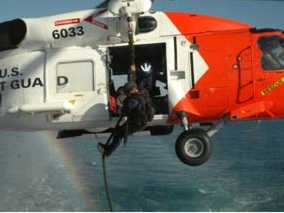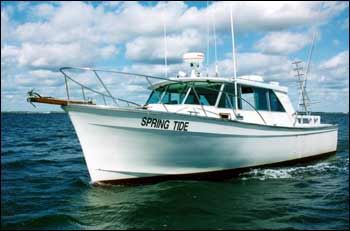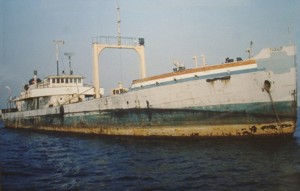Dive Report for the Dina Dee II on June 3,06
52 degree and incredible Vis!
The first stop on this weekend’s dive aboard the Dina Dee II was to the Off-shore Tug. The wreck lies in 90 ft of water off Barnegat Light. It is a broken up steel wreck with a mid sized boiler and engine. The bow and stern protrude from the sand, and there are deck plates poking out here and there.
While the skies were overcast, there was plenty of light as we approached the bottom. We could see the beacon at 40-50 ft. Soon we could see clam shells on the sand. When we hit the bottom, we could see the engine from the bow where the anchor line was tied in. Vis had to be in the 40-50 ft range! Seabass and Tog were all over the engine and boiler. Everywhere a piece of wreckage jutted out of the sand, fish would congregate. Lobsters were abundant, but were either small or had eggs. A couple legal ones did come up, but not in my bag. A few winter flounder swam by taunting me as if they know they are out of season.
I entertained myself with the enjoyable vis bouncy castle for sale and large Seabass population. Bottom time goes quickly at that depth, and before long we headed back to the line. One last Seabass made the mistake of peeking out from under the anchor as we headed up. On the safety stop a few dog fish swam over to check out the equipment lines and divers. While they are common up north, I have not seen them off Barnegat Light before.
On the second dive, we went to the Inshore Tug. While only a few miles away, the vis dropped significantly. From the surface down to 30 ft the water was filled with larval critters. They blocked of much of the light on the bottom. Once on the bottom the vis was about 20 ft. The wreck is a grouping of wooden pieces strewn about the sea floor. It has been broken up over the years by clam dredges. Unless you know your way around, a reel is required even in great vis. We hopped from piece to piece. Some were covered with Seabass, and lobster here and there. Dog fish swam about on the bottom here, sometimes a little too close. After coaxing a few Seabass into my catch bag, we headed back to the boat.
Back on the boat, several of the group were surprised I did not get the large Monkfish that was on the one piece. Honestly, I just didn’t see it. The captains breathed a sigh of relief at the news. We got underway as the sun finally started to come out. Another great day of diving!
 I’m not sure how to start this report, so I guess I start at the beginning.
I’m not sure how to start this report, so I guess I start at the beginning.
 Summary:
Summary: